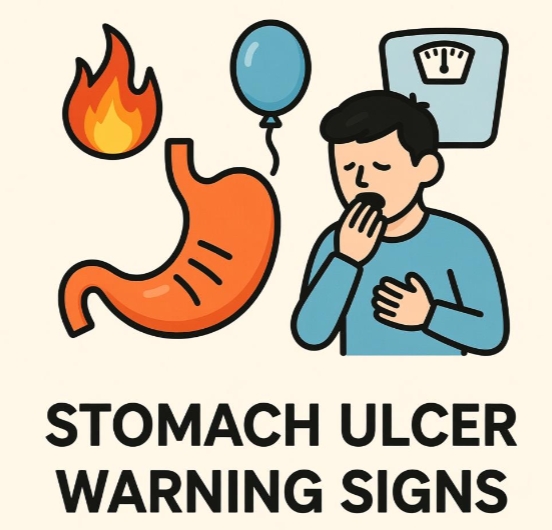Symptoms of gastric ulcer are highly variable.
The most typical is a burning epigastric pain that usually begins 30–60 min after meals and may last from a few minutes to several hours.
Patients often report accompanying dyspepsia, weight loss, nausea or vomiting, and complications such as bleeding or perforation may occur.
Severity parallels ulcer depth; some individuals have no symptoms (“silent ulcer”), while others present initially with haemorrhage or perforation.
Typical pain characteristics
- Onset: 0.5–1 h post-prandial
- Relief: temporary with antacids
- Duration: minutes to hours
- Pattern: recurs over days or weeks
Associated symptoms
- Post-prandial fullness, early satiety, belching
- Loss of appetite and unexplained weight loss
- Nausea, occasionally vomiting (fresh red or coffee-ground blood)
- Melaena (tarry black stools) or dark-red blood per rectum
Disease course
Malignant transformation is rare (<1%). Endoscopy with biopsy is performed only when endoscopic or histological features raise suspicion for cancer.
Summary of Gastric-Ulcer Symptoms
| Category | Key Features (English) |
|---|---|
| Cardinal symptom | Burning epigastric pain, 30–60 min after meals, lasts minutes–hours; temporarily relieved by antacids; recurs over days–weeks. |
| Associated upper-GI symptoms | Post-prandial fullness, early satiety, belching, nausea, vomiting (clear or blood-stained). |
| Systemic / nutritional | Loss of appetite, unexplained weight loss. |
| Bleeding indicators | Hematemesis (fresh red or coffee-ground), melaena (tarry black stools), occasional dark-red rectal blood. |
| Complications | Silent ulcer (no symptoms), acute presentation with haemorrhage or perforation. |
| Malignant potential | <1 % risk of progression to gastric cancer; endoscopy + biopsy if suspicion arises. |
